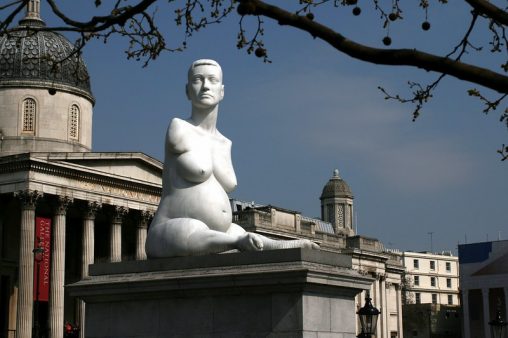The Hidden Problem in Moral Imagination
18 April 2022
- Be more imaginative?
When we fail to treat someone in a morally appropriate way – say, being generous to the stranger in need, fair to the candidate who speaks with an accent, or patient with the friend struggling with anxiety — it is often thought that our lack of imagination is to blame: if only we could just step outside ourselves for a moment and really imagine what the other person is going through, we would better understand their situation and recognize the morally right response.
It seems then that morality requires us to “expand” or “cultivate” our imagination that is otherwise “inert,” “narrow,” “under-developed.” Yet, a little reflection shows that this way of thinking about our failure in moral imagination is misguided. In most cases, our imagination is rather well-developed and actively engaged. The narrator in Ralph Ellison’s Invisible Man finds himself invisible to people around him: “When they approach me they see only my surroundings, themselves, or figments of their imagination – indeed, everything and anything except me.” It certainly takes a robust imagination to blind those people from seeing the reality of the man.
Or consider an example from personal experience described by the writer and philosopher Chloé Cooper Jones in her essay, “Such Perfection”.[1] Born with a rare congenital disorder, her lower body is underdeveloped, her spine curved, and her height never reaching what is typical of adult women. Because of this physical difference, “Romance was for me an incongruent concept. I wanted it, but the world treated me as though I was disqualified from it.” Discussions of attractiveness among her teenage friends left her out not because she was unattractive; “My disability kept me, in the eyes of others, off that scale altogether, like an animal or a child.”
Thus, before we heed moral philosophers’ call to be more imaginative, we must examine how imagination figures in our perception of someone in the first place. In particular, if our imagination of their life is limited by our personal experience, how do we account for the rich imaginary content that too often occupies our minds? I argue that discussions of moral imagination and empathy too often neglect the role of social imagination in shaping an individual’s imagination.
- Perception and social imagination
The term, social imagination, is familiar to sociologists, but it is not foreign to the rest of us. We speak of the mad scientist or the struggling artist that inhabits the “popular imagination,” and the geisha or shaman that captures the “Western imagination.” As members of the same society, we share in a complex collection of images, ideas, associations, metaphors, stories, etc. that form and inform our individual imagination.
We are already aware of the power of images in shaping our perception – we do not just see black or white, man or woman, tall or short, fat or skinny, covered face or bare feet; but we also “see” rich or poor, successful or struggling, beautiful or ugly, competent or lazy, friendly or threatening.
Besides visual representations, stories constitute another important mode of operation of the social imagination. From legends, myths, fables, to literature, films, to news reports, stories “fill in” for us what is missing from our own experiences. When we encounter someone quite different, we fall back on these stories to make sense of them. R. G. Thomson gives a vivid example of how stories impinge on one’s perception of “anomalous” bodies:
These stranger- or larger- or smaller-than-life tales can overwhelm the realities of the actual people whose bodies have given rise to these stories. Thus, our unusually shaped fellow humans can often blur into these creatures for whom they are the human referents. We see people with restricted growth, for example, through folk legends of curmudgeonly dwarfs under bridges or Disney versions of Snow White and her diminutive singing entourage. Tales of Goliaths bested by regular fellows and of plucky boys climbing beanstocks to conquer giants mold conceptions of very large people. Our notions of monsters come from horror stories designed to frighten. In this way, story structures staring.[2]
Concepts and conceptual associations also influence our perception, and they do so not simply in the form of stereotypes, something we are relatively more aware of. Metaphors, connotations, symbols, and the like affect how we see a person in ways that elude even conscientious self-reflection. In her discussion of blindness, Simi Linton opens the chapter as follows:
I once, on a whim, typed the word blind into my computer’s thesaurus. The terms ignorant, imperceptive, insensitive, irrational, oblivious, obtuse, random, rash, stagger, unaware, unconscious, uncontrolled, unknowing, unplanned, and violent came up on my screen. My Roget’s Thesaurus also provided inattentive and purposeless. These meanings lurk under the surface when the word blind is used, whether on its own or in pairings, in such phrases as blind passion, blind rage, blind justice, blind drunk, and blind faith.[3]
Such ableist assumptions are so prevalent in everyday language that we hardly notice them – did you notice my disparaging use of the word, “blind,” earlier in the essay?
- How our imagination falls short
As the above examples show, the problem with our imagination is not just that we often get things wrong, but that it tends to be partial to one set way of seeing the person, which happens to be mistaken. Moreover, the problem goes beyond what we imagine, but our very ability to imagine as well.
The hold of social imagination derives its enduring strength in part from its (hidden) embeddedness in our experience: it is in our language, in the images and stories that surround us; reinforced by our parents, peers, and influencers we follow; encoded into rules of conduct in organizations and society as a whole; and played out in mundane moments of our daily life. Notably, the affective nature of imagination makes us especially susceptible to its power. Unlike beliefs, products of social imagination are bound up with feelings and so move us much more easily. Paul Ricoeur captures the vitality of imagination when he writes, “the imagination radiates out in all direction, reanimating earlier experiences, awakening dormant memories, spreading to adjacent sensorial fields.”[4] It is difficult for reasoning — no matter the evidence and “hard facts” given in support — to match the visceral impact of such things as metaphors and stories.
We should be careful not to dismiss imaginative failures as “merely” a result of stereotypes or biases. Social imagination reaches deep into our psyche (which is also a main reason why stereotypes and biases are hard to eliminate) not only because of its close connection with our affect, but also because it taps into our self-conception. When an able-bodied person meets someone like Chloé Cooper Jones, it is more than just a chance encounter between two strangers, but an occasion that calls into question one’s understanding of a good life, what is normal, what makes us human, what makes life complete, and so on. If what informs our perception of someone else is rooted in the values and meanings informing our self-perception, it is then particularly resistant to change.
By yielding to social imagination habitually and indiscriminately, we can become inflexible, passive, and complacent in exercising our own imagination.
- Transforming imagination
Therefore, it is not entirely wrong to say we need to “expand our moral imagination” – it is true that we need to work on (“expand”) our imaginativeness when perceiving someone, especially someone who appears quite different from us. It is also true that we need to “expand” the possibilities that we imagine, but that does not mean we should overlook what is made readily available to us by social imagination. Indeed, it would be more apt to say the content of our imagination should be corrected or transformed rather than enlarged.
And once we realize this, we will also realize a further, more serious problem with blaming the individual alone for their failure of imagination: it assumes an atomistic picture of the formation of one’s imaginative faculty, its exercise, and its contents. On the contrary, one’s imaginings about someone with a disability, from a different race, and so on are very much products of a social imagination. So long as this fact remains unrecognized, much less addressed, the task of “cultivating one’s moral imagination” is doomed to fail. This is not to deny individual responsibility in reforming their own imaginations, but only to emphasize the urgency and importance of reforming the social imagination at the same time.
[1] Jones, C. C. (2019, June 1). Such Perfection. The Believer. https://believermag.com/suchperfection/
[2] Garland-Thomson, R. (2009). Staring: How we look. Oxford University Press. 167.
[3] Linton, S. (2015). My body politic: A memoir. University of Michigan Press. 213.
[4] Ricoeur, P. (2016). Imagination in Discourse and in Action. In Rethinking imagination. Routledge. 122-23.
Picture: Dave Rutt picture of sculpture by Marc Quinn, Alison Lapper Pregnant
- April 2024
- March 2024
- February 2024
- January 2024
- December 2023
- November 2023
- October 2023
- September 2023
- August 2023
- July 2023
- June 2023
- May 2023
- April 2023
- March 2023
- February 2023
- January 2023
- December 2022
- November 2022
- October 2022
- September 2022
- August 2022
- July 2022
- June 2022
- May 2022
- April 2022
- March 2022
- February 2022
- January 2022
- December 2021
- November 2021
- October 2021
- September 2021
- August 2021
- July 2021
- June 2021
- May 2021
- April 2021
- March 2021
- February 2021
- January 2021
- December 2020
- November 2020
- October 2020
- September 2020
- August 2020
- July 2020
- June 2020
- May 2020
- April 2020
- March 2020
- February 2020
- January 2020
- December 2019
- November 2019
- October 2019
- September 2019
- August 2019
- July 2019
- June 2019
- May 2019
- April 2019
- March 2019
- February 2019
- January 2019
- December 2018
- November 2018
- October 2018
- September 2018
- August 2018
- July 2018
- June 2018
- May 2018
- April 2018
- March 2018
- February 2018
- January 2018
- December 2017
- November 2017
- October 2017
- September 2017
- August 2017
- July 2017
- June 2017
- May 2017

